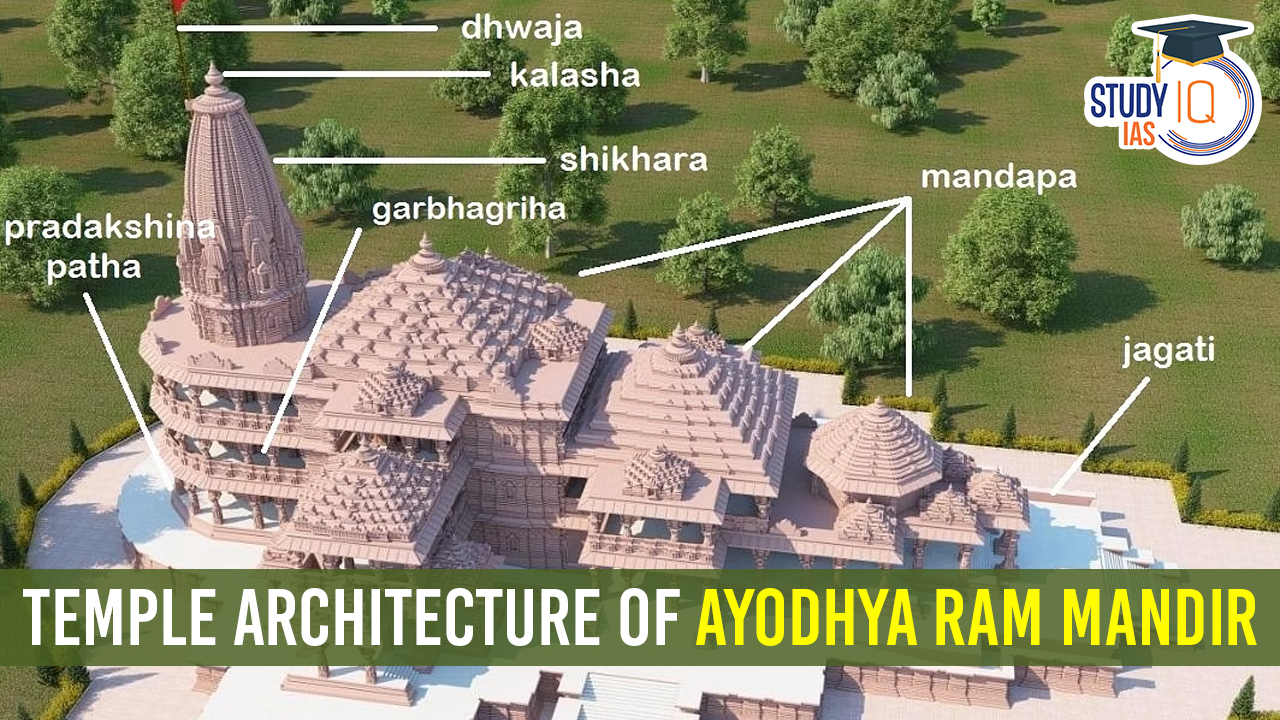Table of Contents
The Ayodhya Ram Mandir stands as a monumental testament to the devotion and religious fervor of millions of Hindus worldwide. As the first anniversary of its Pran Pratishtha ceremony approaches, Know all about the Temple Architecture of Ayodhya Ram Mandir in this article.
Pran Pratishtha Ceremony
The Pran Pratishtha ceremony of the Ram Mandir took place on January 22, 2024. This consecration ritual, where the deity’s idol is infused with life through sacred rites, marked the temple’s spiritual inauguration. The ceremony was conducted with great pomp and reverence, attended by prominent saints, scholars, and devotees.
Why Celebrate on January 11, 2025?
While the original Pran Pratishtha ceremony occurred on January 22, 2024, the first anniversary is celebrated on January 11, 2025. This adjustment is based on the traditional Hindu calendar. The Pran Pratishtha was performed on Paush Shukla Paksha Dwadashi, also known as Kurma Dwadashi. In 2025, this auspicious date falls on January 11, prompting the temple trust to commemorate the anniversary accordingly.
How Technology Helped Ram Lalla Surya Tilak at Ayodhya Ram Mandir?
- Optomechanical System: Utilized an optomechanical setup to converge and focus sunlight onto Ram Lalla’s forehead.
- Infrared Filter: Integrated an infrared filter made of heat-absorbing material at the aperture to block high-energy photons and prevent heat transfer to the idol.
- Precision Engineering: Combined four lenses and mirrors at specific angles inside brass pipes to direct sunlight onto the idol with accuracy.
- Light Scattering Prevention: Coated inner surfaces of pipes, elbows, and joints with black powder to minimize light scattering.
- No Electronic Dependency: Operated without batteries or electronic devices, ensuring longevity and ease of maintenance through manual adjustments.
Temple Architecture of Ayodhya Ram Mandir Overview
| Aspect | Details |
| Chief Architects | Chandrakant Sompura, Nikhil Sompura, Ashish Sompura |
| Design Advisors | IIT Guwahati, IIT Chennai, IIT Bombay, NIT Surat, CBRI Roorkee, NGRI Hyderabad, NIRM |
| Construction Company | Larsen and Toubro (L&T) |
| Project Management Company | Tata Consulting Engineers Limited (TCEL) |
| Sculptors | Arun Yogiraaj (Mysore), Ganesh Bhatt, Satyanarayan Pandey |
| Total Area | 70 Acres (70% Green Area) |
| Temple Area | 2.77 Acres |
| Temple Dimensions | Length: 380 Ft., Width: 250 Ft., Height: 161 Ft. |
| Architectural Style | Indian Nagar Style |
| Architectural Highlights | 3 Stories, 392 Pillars, 44 Doors |
Features of Temple Architecture of Ayodhya Ram Mandir
The construction of the Shri Ram Janmabhoomi Mandir in Ayodhya is a significant project undertaken in the traditional Nagara architectural style. Here are the details of the construction of Ayodhya Ram Mandir in a more detailed manner:
| Aspect of Architecture | Details |
| Architectural Style | Predominantly Nagara style with a towering shikhara and raised plinth, incorporating elements from Dravida style. |
| Dimensions | 380 feet length, 250 feet width, and 161 feet height, featuring 392 pillars and 44 doors. |
| Construction Material | Primarily pink sandstone, symbolizing cultural and divine reverence. |
| Vastu Shastra and Shilpa Shastra | Integration of principles from Vastu Shastra for spatial harmony and cosmic alignment, and Shilpa Shastra for traditional art and craftsmanship. |
| Boundary Wall | A 732-meter-long surrounding wall, influenced by Dravida style temples, adding a hybrid characteristic to the design. |
| Construction Techniques | Innovative use of a lock and key mechanism instead of cement or lime mortar in joints. |
| Symbolism and Significance | Represents a celebration of India’s cultural diversity and unity, with a fusion of architectural styles and incorporation of ancient design principles. |
| Cultural Unity | The temple serves as a monumental work of art and devotion, weaving together diverse architectural influences, showcasing India’s rich cultural heritage and unity. |
Characteristics of Ayodhya Ram Mandir
Dimensions and Structure
- Length (east-west): 380 feet
- Width: 250 feet
- Height: 161 feet
- Three-storied structure, each floor being 20 feet tall.
Architectural Features
- Traditional Nagara style.
- Supported by 392 pillars and 44 doors.
- Pillars and walls are intricately sculpted with depictions of Hindu deities.
- Five mandaps (halls): Nritya Mandap, Rang Mandap, Sabha Mandap, Prathana Mandap, and Kirtan Mandap.
- The main sanctum sanctorum features the childhood form of Bhagwan Shri Ram (Shri Ram Lalla).
- The first floor has a Shri Ram Darbar.
Temple Compound
- The main entrance on the eastern side, is accessed by ascending 32 stairs through the Singh Dwar.
- Four Mandirs at the corners are dedicated to Surya Dev, Devi Bhagwati, Ganesh Bhagwan, and Bhagwan Shiv.
- Additional Mandirs for Maa Annapurna and Hanuman ji in the northern and southern arms respectively.
Foundation and Stability
- The foundation is supported by a substantial number of columns.
- Ground floor: 160 columns, First floor: 132 columns, Second floor: 74 columns.
- Provisions for ramps and lifts for the differently-abled and elderly.
- Parkota (Rectangular compound wall) with a length of 732 meters and a width of 14 feet surrounds the Mandir.
Construction Materials
- Bansi Paharpur Pink Sandstone from Rajasthan’s Bharatpur district for the main temple structure.
- Granite stones for plinths, provide durability and resilience.
- White Makrana marble and coloured marble for intricate inlay work.
- Special bricks called “Ram Shilas” with the inscription “Shri Ram” on them.
Construction Techniques
- Unique approach by avoiding the use of steel or iron.
- Use of traditional construction materials aligning with age-old building practices.
- Roller-compacted concrete (RCC) with a 14-meter-thick layer for the appearance of artificial rock.
Symbolic Elements
- The inscription on Ram Shilas draws a symbolic parallel with the stones believed to have been used in the construction of Ram Setu.
- Proposed Mandirs dedicated to various sages and revered figures.
Utilities and Facilities
- 21-foot-high plinth for protection against ground moisture.
- Sewage treatment plant, water treatment plant, water supply for fire safety, and an independent power station.
- Pilgrims Facility Centre (PFC) with a capacity of 25,000 people provides medical facilities and locker facilities.
- Separate block with bathing area, washrooms, washbasin, open taps, etc.
Environmental Considerations
- 70% of the 70-acre area is left green.
- Construction with a focus on environmental water conservation.
Financials
- Estimated expenditure of ₹1,800 crore for the entire project.
- ₹900 crore reported expenditure between February 5, 2020, and March 31, 2023.
Nagara Style of Temple Architecture
Originating in ancient India, Nagara is a prominent style of temple architecture.
Characteristics
- Shikhara: Towering spire crowning the sanctum.
- Mandapa: Pillared hall for gatherings.
- Garbhagriha: Sanctum housing the main deity.
- Amalaka: Circular stone at the top of the shikhara.
- Kalasha: Decorative finial atop the spire.
Components
- Vimana: Towering structure above the sanctum.
- Antarala: Vestibule connecting mandapa and garbhagriha.
- Hypostyle Hall: Pillared prayer hall.
Ornamentation
- Elaborate carvings of deities, mythical creatures, and motifs.
- Intricate friezes depicting epics.
Regional Variations
- North India: Elongated shikharas.
- Central India: Blend of Nagara and Dravida styles.
- Western India: Elaborate ornamentation.
Influence
- Dominant in North Indian temples, especially in states like Rajasthan and Gujarat.
Symbolism
- Reflects the cosmic mountain, symbolizing the abode of gods.
Temple Architecture of Ayodhya Ram Mandir UPSC
The Ayodhya Ram Mandir, a three-story marvel, epitomizes the Nagara style of Hindu temple architecture. Led by architects Chandrakant Sompura and sons, it spans 380x250x161 feet, boasting 392 pillars and 44 doors. Melding Nagara and Dravida styles, it integrates Vastu Shastra, Shilpa Shastra, and a 732-meter wall. The innovative lock and key construction, eco-conscious design, and cultural symbolism make it a unifying cultural icon. Financially, ₹1,800 crores are estimated, with ₹900 crores spent till March 2023.


 Places in News for UPSC 2025 for Prelims...
Places in News for UPSC 2025 for Prelims...
 Bihu Festival and Dance of Assam, Histor...
Bihu Festival and Dance of Assam, Histor...
 New Phase of Operation Chakra to Combat ...
New Phase of Operation Chakra to Combat ...





















